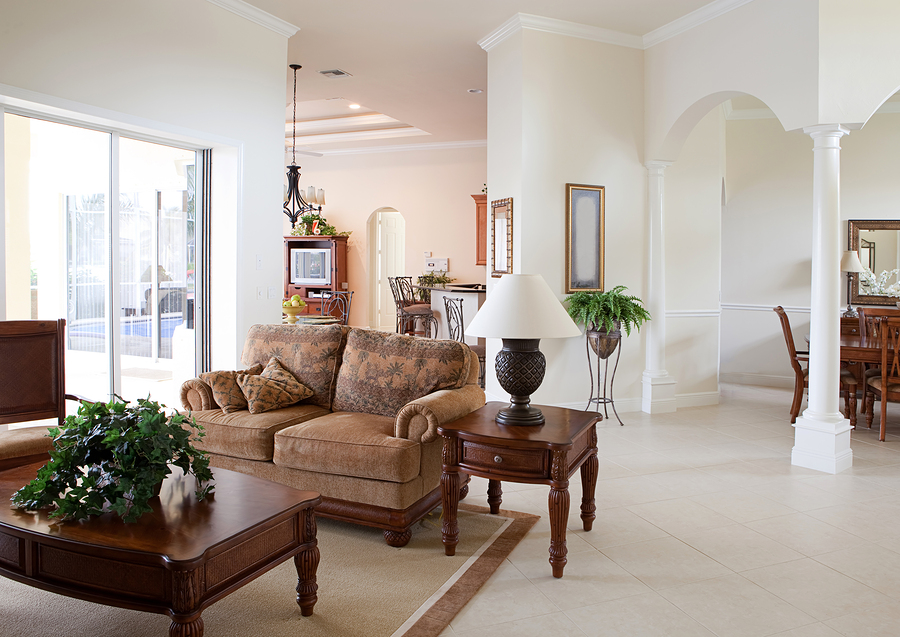
Home interior with nice volume in the space, hard surface flooring, good lighting (including daylighting), and easily traveled passageways – with furniture appropriately sized for the space
No matter how we approach working with our aging in place clients, and regardless of their profile (age, ability, income, style or age of housing, or household size), the one consideration that gets top billing is safety. Everything we do should revolve around and center on providing the safest environment possible for our clients with the budget they have and accommodating their expressed and perceived needs.
There are three primary areas within the home where we can focus our energies to create the safest solutions possible for our clients: surfaces, mechanics, and volume.
Looking these in reverse order, we’ll begin with volume which is an inclusive term I use to apply to the interior of the home, and it covers all soft and non-specific areas. The components of volume as used here include lighting, air quality, clear passage, glare, general comfort, doorways, passageways, and where objects in the home (fixed such as cabinets, appliances, and bath fixtures, or non-fixed such as furnishings) are located as well as how they are sized appropriately for the users and in the space where they are located and found.
Lighting is something that we can see when it’s present but may not appreciate to what extent it’s insufficient when it’s not present to the extent that is beneficial. As we get older (all of us), we require more lighting to see, read, and wayfind. This is a large component of establishing safety in the home – being able to see where are going without tripping over objects or running into them because they are in shadows or partially concealed. Stronger, more plentiful, and more adequate lighting helps to alleviate this safety issue.
Air quality is an often overlooked issue that many people don’t even consider. Of course, cooking odors are noticeable, but what about more unobserved and potentially hazards fumes (mold or carbon monoxide, for instance) or poor quality interior air that might exist in our homes? On spring days, this is one of the reasons people enjoy opening their windows and airing out their homes after having them closed all winter, However, as newer homes are being built with more fixed pane windows and tighter building envelopes, opening windows for ventilation is becoming less common. True, an exchanger will add make-up air, but it may not flush the home the same way as breezes blowing through it.
As for surfaces, these manifest themselves in several ways. We are concerned with flooring, walls, counters, cabinets, appliances, bath fixtures, furniture, and anything else that people in the home may walk on, sit on, stand against, open, enter, use, operate, or otherwise come into contact with them. People need to be reasonably assured that their homes are going to be safe with respect them navigating and using their home in a prudent way – as those surfaces and objects are intended. Obviously, if we are careless or hasty accidents can happen. We can cut ourselves or slip and fall. These are not generally the fault of the surfaces if they are designed correctly.
However, when the surfaces, especially flooring or glossy flat surfaces anywhere in the home that might create an unexpected or inordinate amount of glare, are problematic, we need to remediate them with safer ones. This could require flooring treatments or new flooring, window treatments, different types or styles or furniture, or other modifications – not necessarily elaborate or expensive – to make the home safer for the occupants.
Essentially, surfaces need to be substantial to the point of supporting us and safe in the same respect so that slips or other accidental contact is eliminated or greatly reduced.
Mechanics is related to the other two – actually all three are related. Mechanics refers to how people use their homes – their mobility. It also relates to their senses. Thus, someone’s mobility (how they get around, access and use switches and controls, open cabinets and drawers, open and go through doorways, and how they use other objects in their homes such as appliances, furniture, and bath fixtures) might be adequate, but their vision or balance isn’t as strong. Still, they could have issues in navigating their space.
Regardless, how well people see in their homes (lighting, brightness, the absence of glare, and sufficient contrast to indicate where the edges of objects are), how they are able to use the objects in their homes because they are not concerned about injury from contacting or operating them in a normal, everyday manner, and how they are able to maneuver within their space whether they have any physical or sensory limitations or not all contribute to a feeling of well-being and safety (as well as a measure of security) in their homes. We are responsible for helping them to achieve this through the evaluations and solutions we provide.
